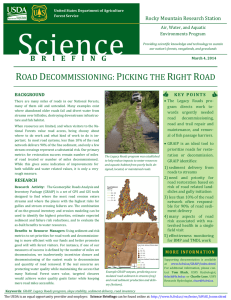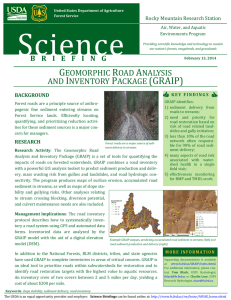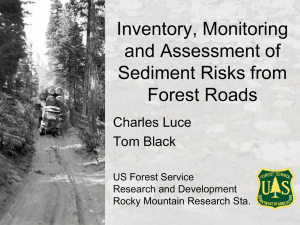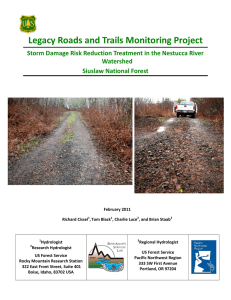Mass Wasting
advertisement
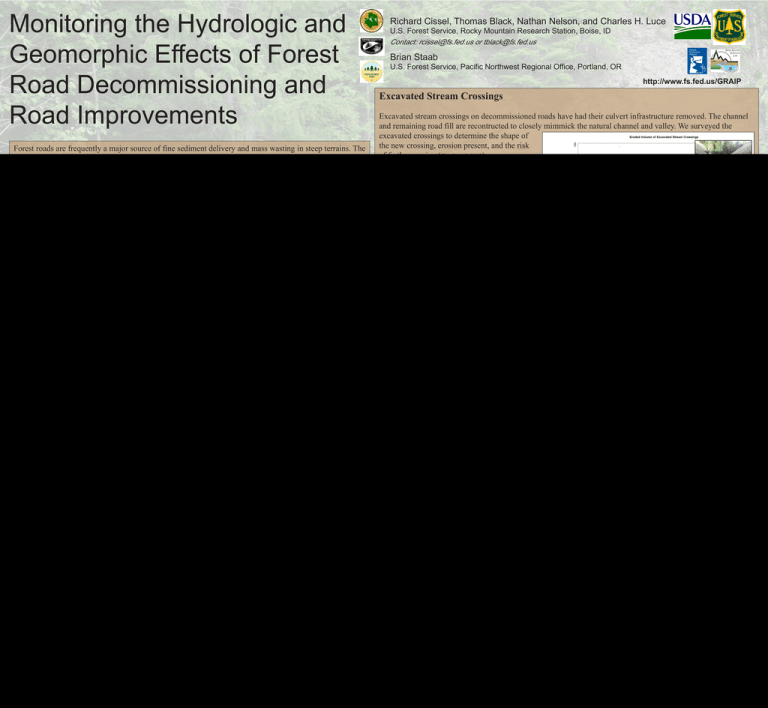
Monitoring the Hydrologic and Geomorphic Effects of Forest Road Decommissioning and Road Improvements Richard Cissel, Thomas Black, Nathan Nelson, and Charles H. Luce U.S. Forest Service, Rocky Mountain Research Station, Boise, ID Contact: rcissel@fs.fed.us or tblack@fs.fed.us Brian Staab U.S. Forest Service, Pacific Northwest Regional Office, Portland, OR http://www.fs.fed.us/GRAIP Excavated Stream Crossings Forest roads are frequently a major source of fine sediment delivery and mass wasting in steep terrains. The U.S. Forest Service operates over 616,000 kilometers of forest roads in a wide variety of landscapes. The USFS Legacy Roads Program has been working to address the environmental impact of this large road network by decommissioning or upgrading roads that historically have caused water quality impacts. The Legacy Roads Monitoring Project has developed a method and is monitoring a sample of 52 of these projects in order to establish the efficacy of the treatments over time and in a range of environments. The Geomorphic Roads Analysis and Inventory Package (GRAIP) is a GPS based road inventory paired with a set of GIS tools designed to quantify the most common hydrologic and geomorphic problems associated with forest roads. GRAIP is combined with other field observations to evaluate: • Fine sediment delivery • Excavated stream crossings on decommissioned roads • Mass wasting risks • Road surface erosion problems Map of monitored Legacy Roads sites and other GRAIP studies. Objective: To quantify the effectiveness of decommissioning (n=15) and storm damage risk reduction (SDRR; n=11) road treatments at reducing risk to watersheds. Treatment Methods Pre-Treatment Post-Treatment Volume of Fill Removed Volume of Erosion in Crossings Mean Depth of Total Mean Total Volume Mean Volume Site Erosion Volume (m3) Volume (m3) (m3) (m3) (m3) 3,040 510 70 10 0.5 Boise NF, Squaw Creek, 2009 Clearwater NF, Potlatch River, 2010 3,490 580 60 10 0.3 Dixie NF, Mammoth Creek, 2010 780 260 20 10 0.3 Flathead NF, Flathead River, 2009 12,990 1,620 230 30 0.4 Mt. Baker-Snoqualmie NF, Baker River, 2009 1,500 1,500 150 150 0.6 Mt. Baker-Snoqualmie NF, Suiattle River, 2008 10,220 1,140 130 10 0.4 Olympic NF, Skokomish River, 2008 63,990 5,330 830 70 0.8 Payette NF, Calf Creek, 2009 4,140 1,040 110 30 0.6 Payette NF, Mann Creek, 2009 8,140 630 250 20 0.4 Rogue River-Siskiyou NF, Applegate River, 2010 1,840 610 20 10 0.1 Siuslaw NF, Alsea River, 2008 28,250 2,020 120 10 0.2 Six Rivers NF, Klamath River, 2009-2010 6,790 1,360 100 20 0.5 Umatilla NF, Granite Creek, 2008 2,940 420 40 10 0.2 Umatilla NF, Wall Creek, 2008 3,360 480 70 10 0.3 Umpqua NF, South Umpqua River, 2009 22,850 1,900 490 40 0.4 Willamette NF, Middle Fork Willamette River, 2010 7,550 630 110 10 0.4 Total 181,890 1,490 2,790 20 0.4 As the new channel adjusts, some erosion is expected at excavated stream crossings. While the mean volume eroded for all sites was low relative to previous findings (Cook and Dresser 2010), a few sites had significantly higher eroded volumes. Volumes may vary with precipitation, channel sizes (bigger streams erode more and wider channels inherently have more volume), natural slopes, or with design and implementation standards (matching the excavation to the natural channel and valley). Eroded volumes were 15% of the total that could be expected to erode over time as the untreated crossings failed. SDRR Road Surface Erosion Mass Wasting Road surface and flowpath condition problems include gullies, rills, buried ditch lines, ruts, and stream diversion courses. Shallow landslides and gullies that meet a minimum threshold for size are measured or estimated to determine volume. Even after a storm event, most sites did not have any new mass wasting events. Gullies often initiate below new drainage points when they have a long contributing length of road or discharge onto a steep or unstable slope. Post-Storm Event Control The effectiveness of road treatments were measured using a before-after-control impact design (BACI). The GRAIP outputs and associated field observations were used as indicators of the state of risk. Excavated stream crossings on decommissioned roads have had their culvert infrastructure removed. The channel and remaining road fill are recontructed to closely mimmick the natural channel and valley. We surveyed the excavated crossings to determine the shape of the new crossing, erosion present, and the risk of further erosion (Black et al. 2012). A ~6 km sample of road was inventoried for both treatment and control sites. Control sites were selected based on their proximity and similarity to treated sites with respect to road construction methods, maintenance levels, geology, and hydrologic regimes. Each study site was inventoried before road treatments occurred, and again after a greater-than 7 year recurrence interval storm event. Sediment Delivery Sediment delivery was calculated for each segment of road according to observations and the following equation (Luce and Black 1999, Cissel et al. 2012): E=B×L×S×V×R E is the erosion for each road segment (kg/yr) B is the base erosion rate (kg/m) L is the road length (m) contributing to the drain point S is the slope of the road contributing to the drain point (m/m) V is the vegetation cover factor for the flow path R is the road surfacing factor Length of Surface Condition Problems Flowpath Condition Problems Road %, Pre%, PostΔ % %, Pre%, PostΔ % Site Type Treated Treatment Storm Event Length Change Treatment Storm Event Length Change (m) Length Length (m) Length Length Length (m) Length SDRR Treatment 85,990 10% 1% -7,970 -89% 10% 6% -3,140 -36% SDRR Control 68,310 5% 2% -2,080 -56% 12% 15% 2,250 27% Road treatments have met or exceeded sediment production and delivery, and hydrologic connectivity expectations for both decommissioning and SDRR roads, with the exception of sediment production on SDRR roads. Expected Changes in Connectivity and Sediment, Pre-Treatment to PostStorm Event Decommissioned Roads Δ Road-Stream Hydrologic Connectivity Compared to the control roads, both decommissioning and SDRR treatments were effective at reducing sediment delivery to streams at most sites. This is due to decreases in sediment production and disconnection of roads from streams, with the former dominating SDRR roads. Δ Sediment Production from Road Surfaces Δ Sediment Delivery from Road Surfaces SDRR Roads Control Roads large decrease small to moderate decrease small increase small to moderate decrease small decrease small increase large decrease small to moderate small to moderate decrease increase Changes in Connectivity and Sediment, Pre-Treatment to Post-Storm Event Decommissioned Roads (n = 15) SDRR Roads (n = 11) Treated Roads (97.4 km) Control Roads (92.5 km) Treated Roads (85.6 km) Control Roads (71.1 km) Δ Road-Stream Hydrologic Connectivity Δ Sediment Production from Road Surfaces Δ Sediment Delivery from Road Surfaces Δ Unit Sediment Delivery from Road Surfaces -12.5 km (-62%) +1.2 km (+6%) -0.9 km (-3%) no change (-0.1%) -451 Mg/yr (-56%) -68 Mg/yr (-10%) -418 Mg/yr (-53%) -281 Mg/yr (-49%) -208 Mg/yr (-79%) +47 Mg/yr (+35%) -125 Mg/yr (-61%) -34 Mg/yr (-34%) -2.1 Mg/km/yr (-79%) +0.5 Mg/km/yr (+34%) -1.5 Mg/km/yr (-61%) -0.4 Mg/km/yr (-34%) Road surface and flowpath condition problems were both successfully addressed by the SDRR treatments. Control roads experienced an increase in flowpath condition problems, and a decrease in surface condition problems. The decrease was much smaller than that of the treated roads. Landslides Gullies Length PreVolume % New PreVolume % New Site Type of Road Number Number Treatment of New Volume of Treatment of New Volume of (km) of New of New Volume (m3) (m3) Pre Volume Volume (m3) (m3) Pre Volume Decom Treatment 97 84,150 12 1,000 1% 1,930 20 590 30% Decom Control 92 20,050 6 2,110 11% 1,210 23 140 11% SDRR Treatment 86 9,270 5 1,030 11% 8,650 59 13,680 158% SDRR Control 71 7,380 4 10 0.2% 2,340 30 380 16% Decommissioning treatments, which prevent roads from concentrating water in large volumes, were successful at reducing risk from both gullies and landslides. SDRR treatments, which leave water concentrated and may discharge at new locations, were less successful, particularly in relation to new gully formation. Conclusions • Fine sediment delivery was reduced 79% by decommissioning, and 61% by SDRR. • Overall, both treatment types were effective compared • Further work to determine fine-scale causes behind to control roads. these increases and reductions, as well as examine • Exceptions: new gullies on SDRR roads, large erosion BMPs and develop tools for managers to use to prevent volumes at some excavated stream crossings, localized problems and further reduce impacts and risk to increases in flowpath condition problems. watersheds from forest roads. Black, T. A., Cissel, R. and Luce, C. H. 2012. The Geomorphic Road Analysis and Inventory Package (GRAIP) Volume 1: Data Collection Method. Gen. Tech. Rep. RMRS-GTR-280WWW. Fort Collins, CO: U.S. Department of Agriculture, Forest Service, Rocky Mountain Research Station. Cissel, R. M., Black, T. A., Schreuders, K. A. T., Prasad, A., Luce, C. H., Nelson, N.A., Tarboton, D.G., and Nelson, N. A. 2012. The Geomorphic Road Analysis and Inventory Package (GRAIP) Volume 2: Office Procedures. Gen. Tech. Rep. RMRS-GTR-281WWW. Fort Collins, CO: U.S. Department of Agriculture, Forest Service, Rocky Mountain Research Station. Cook, C., and Dresser, A. 2010. Erosion and Channel Adjustments Following Forest Road Decommissioning, Six Rivers National Forest. In M Furniss, C Clifton, and K Ronnenberg, eds., 2007. Advancing the Fundamental Sciences: Proceedings of the Forest Service National Earth Sciences Conference, San Diego, CA, 18-22 October 2004, PNW-GTR-689, Portland, OR: US Department of Agriculture, Forest Service, Pacific Northwest Research Station. Luce, C.H., and Black, T. 1999. Sediment production from forest roads in western Oregon. Water Resources Research. Vol. 35, No. 8, pp: 2561-2570.

